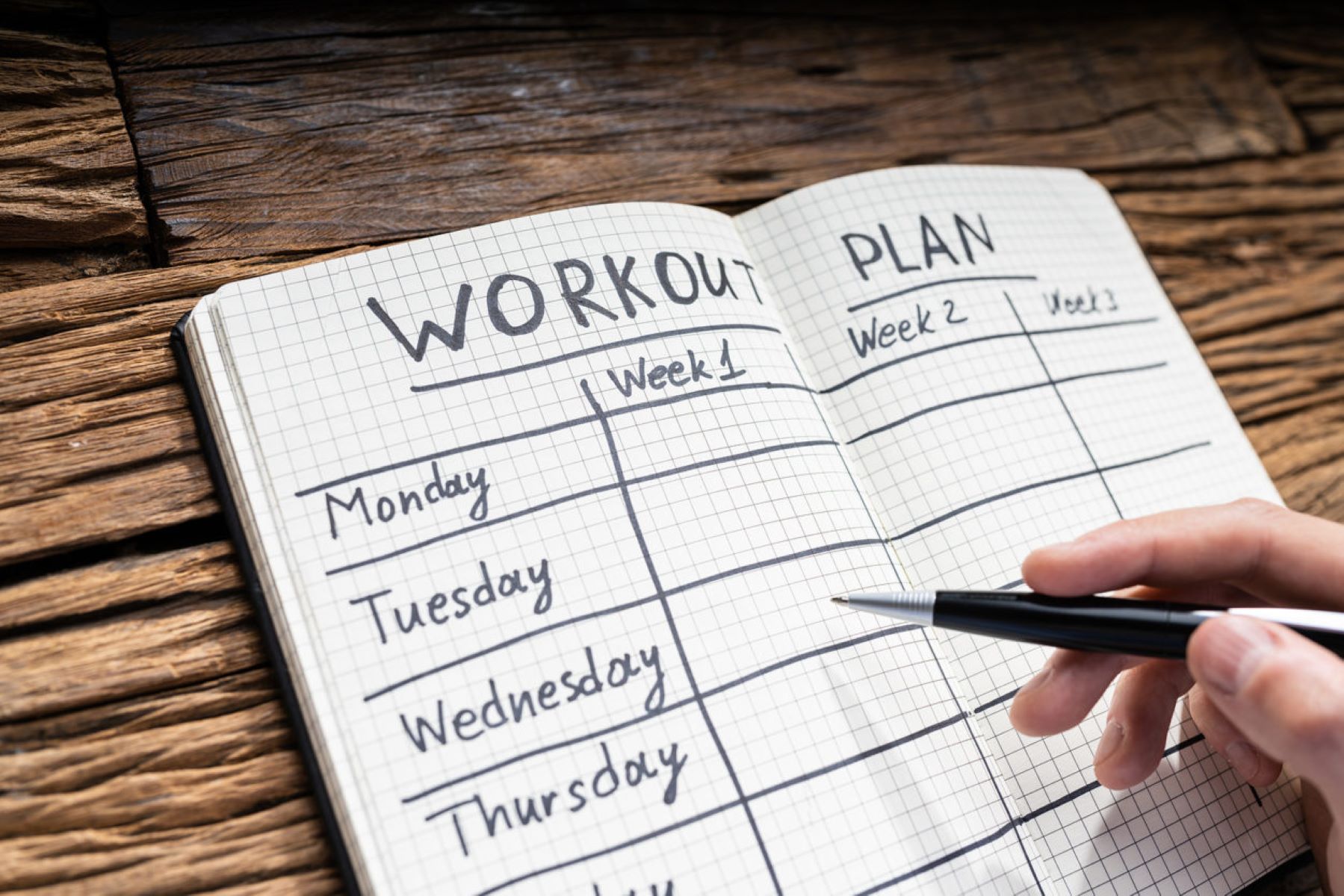

Featured
How Often To Change Workout Routine
Modified: August 19, 2023
Discover the optimal frequency to switch up your workout routine on Featured. Keep your fitness regimen effective and avoid hitting a plateau.
Introduction
Welcome to the world of fitness, where there’s never a shortage of workout routines to choose from. Whether you’re a seasoned gym-goer or just starting your fitness journey, one question often arises: how often should you change your workout routine?
Changing your workout routine can be both exciting and challenging. On one hand, it keeps your workouts fresh and helps prevent boredom. On the other hand, it allows you to target different muscles and avoid plateaus in your progress.
But finding the right balance between sticking with a routine long enough to see results and changing things up to keep the body guessing can be tricky. This is where understanding the benefits of changing your workout routine and considering various factors comes into play.
In this article, we will explore the benefits of changing your workout routine, discuss some factors to consider when deciding how often to change it, and provide some common recommendations. We will also highlight signs that indicate it’s time to make a change and offer tips on how to effectively transition to a new workout routine.
So, if you’re ready to dive into the world of workout routine changes with a fresh perspective, let’s get started!
Benefits of Changing Workout Routine
Changing your workout routine on a regular basis can offer a myriad of benefits for your physical fitness and overall well-being. Here are some key advantages to consider:
- Prevents Plateaus: When you perform the same exercises and routines repeatedly, your body adapts to the stress and becomes more efficient, resulting in diminished results. By changing your workout routine, you introduce new challenges and stimuli, preventing plateaus and ensuring ongoing progress.
- Targets Different Muscles: Different exercises target different muscle groups. By constantly changing your routine, you can ensure that you’re working out all areas of your body and achieving a balanced physique. It also helps reduce the risk of overuse injuries associated with repetitive movements.
- Breaks Boredom: Repeating the same workout routine day after day can become monotonous and lead to boredom. Changing your routine keeps things fresh and exciting, making it easier to stay motivated and committed to your fitness goals.
- Improves Mental Stimulation: Variety in your workouts not only benefits your body but also stimulates your mind. Trying new exercises and routines challenges your brain, improving cognitive function and enhancing your overall mental well-being.
- Enhances Overall Fitness: By incorporating different types of exercises into your routine, such as cardiovascular workouts, strength training, and flexibility exercises, you can improve your overall fitness level. This holistic approach ensures that you’re targeting multiple aspects of fitness, leading to improved endurance, strength, and flexibility.
Overall, changing your workout routine is a powerful strategy to maximize your results, keep your workouts interesting, and overcome plateaus. It allows you to continuously challenge yourself, work out different muscle groups, and maintain your motivation for long-term success in your fitness journey.
Factors to Consider When Deciding How Often to Change Workout Routine
While changing your workout routine can have numerous benefits, it’s important to consider several factors when determining how often to make these changes. Here are some key factors to keep in mind:
- Experience Level: Beginners may benefit from sticking to a routine for a longer period to establish a foundation of strength and technique. Advanced individuals, on the other hand, might change their routines more frequently to keep challenging their bodies.
- Goals: Your fitness goals play a significant role in deciding how often to change your workout routine. If your aim is to build muscle, you may need to follow a consistent routine for several weeks to allow for progressive overload. If your goal is weight loss or overall fitness, changing your routine every few weeks can help keep your body guessing and prevent stagnation.
- Adaptation Rate: Understanding how quickly your body adapts to exercises is crucial. If you notice that you’re no longer feeling challenged or seeing progress, it may be time to switch things up. However, if you’re still making gains and enjoying your routine, there’s no rush to change.
- Time Availability: Changing your workout routine requires time and effort to learn new exercises and adjust your training schedule. Consider your lifestyle and commitments when deciding how often to make changes. If you have limited time, tweaking small aspects of your routine can be just as effective as a complete overhaul.
- Injury Prevention: Consistently changing your routine can increase the risk of injuries, especially if you’re not allowing your body enough time to adapt and recover. Pay attention to any signs of overtraining or excessive stress on your joints and muscles and adjust your routine accordingly.
- Personal Preference: Ultimately, how often you change your workout routine also depends on personal preference. If you thrive on variety and enjoy constantly exploring new exercises, you may choose to change your routine more frequently. However, if you prefer consistency and find comfort in a familiar routine, you may opt for longer periods before making significant changes.
Considering these factors will help you strike the right balance between keeping your workouts fresh and ensuring optimal progress towards your fitness goals. It’s important to remember that there is no one-size-fits-all approach, and what works for one person may not work for another.
Common Recommendations for Changing Workout Routine
When it comes to how often to change your workout routine, there are some common recommendations that can serve as a starting point. While these recommendations may vary depending on individual factors, they can provide useful guidelines for structuring your fitness journey:
- Every 4-6 Weeks: One common recommendation is to change your workout routine every 4-6 weeks. This timeframe allows you to give your body enough time to adapt and make progress while preventing stagnation. It’s a good balance between consistency and variety.
- Based on Progress: Another approach is to change your routine when you notice a plateau in your progress. This can involve adjusting the intensity, volume, or exercises to challenge your body in new ways. Pay attention to your strength gains, improvements in endurance, and overall performance to determine when it’s time for a change.
- Periodization: Periodization is a systematic approach to training that involves dividing your workout routine into different phases. These phases can vary in intensity, volume, and focus. By following a periodized approach, you can change your routine every few weeks or months to target different aspects of fitness and prevent plateaus.
- Listen to Your Body: Your body is a great source of information. Pay attention to how you feel during and after your workouts. If you’re constantly fatigued, experiencing persistent muscle soreness, or lacking motivation, it may be a sign that you need to change your routine. On the other hand, if you’re making progress and feeling energized, there’s no need to rush into a change.
- Variety within Each Session: Changing your routine doesn’t always mean completely overhauling it. You can incorporate variety within each workout session by mixing up exercises, using different training modalities, or adjusting the sets and reps. This approach keeps things interesting and challenges your body without the need for frequent major changes.
Remember, these recommendations are not set in stone, and it’s important to find what works best for you. Experiment with different approaches, listen to your body, and be open to making adjustments along the way. The key is to strike a balance between consistency and variety to keep your workouts enjoyable and effective in the long run.
Signs That It’s Time to Change Your Workout Routine
Recognizing when it’s time to change your workout routine is essential for continued progress and avoiding boredom or stagnation. Here are some signs that indicate it may be time for a change:
- Plateaued Progress: If you’ve been following the same routine for weeks or months and are no longer seeing improvements in strength, endurance, or body composition, it may be a sign that your body has adapted and it’s time to switch things up.
- Boredom and Lack of Motivation: If your workouts have become monotonous and you find yourself dreading the gym or lacking the motivation to exercise, it’s a clear indication that you need to introduce some variety into your routine to reignite your enthusiasm.
- Feeling Unchallenged: A workout routine should push your limits and challenge you physically. If you find that your current routine has become too easy, and you’re not feeling challenged during your workouts, it’s a sign that you need to increase the intensity or introduce new exercises to stimulate your muscles.
- Injury or Overuse: If you’re experiencing recurring injuries or persistent muscle soreness from your current routine, it’s crucial to assess whether certain exercises or movements may be causing excessive stress on your body. Changing your routine can help alleviate these issues and allow for proper recovery.
- Lack of Progress in Specific Areas: If you have specific fitness goals, such as building strength or improving flexibility, and you’re not seeing progress in those areas despite consistent effort, it may indicate that your current routine is not effectively targeting those goals. Adjusting your routine to focus more on those areas can help break through the plateau.
- Changes in Schedule or Lifestyle: Life circumstances, such as a new job or a change in schedule, can impact your ability to stick to a particular workout routine. If your previous routine no longer fits your current lifestyle, it may be time to design a new plan that aligns with your availability and priorities.
By paying attention to these signs and being aware of your body’s cues, you can proactively make changes to keep your workouts effective and enjoyable. Remember, listening to your body is key, and making adjustments to your routine when necessary will help you continue progressing towards your fitness goals.
Tips for Effectively Changing Your Workout Routine
Changing your workout routine can be an exciting and challenging endeavor. To ensure a smooth transition and maximize the benefits of a new routine, consider the following tips:
- Set Clear Goals: Before starting a new routine, define your goals. Whether it’s building strength, improving endurance, or losing weight, having clear objectives will guide your exercise selection and help you stay focused.
- Gradual Progression: When implementing a new routine, avoid sudden, drastic changes. Gradually introduce new exercises, increase weights or resistance, or adjust the duration and intensity over time. This allows your body to adapt and reduces the risk of injury.
- Seek Professional Guidance: If you’re new to changing workout routines, consider working with a certified fitness professional who can design a tailored plan based on your goals, experience, and any specific limitations or concerns you may have.
- Track Your Progress: Keep a workout journal or use a fitness tracking app to record your exercises, sets, reps, and weights. This allows you to track your progress, identify areas of improvement, and make necessary adjustments as you go.
- Explore Variety: Don’t be afraid to try new exercises, training methods, or classes. Variety keeps your workouts interesting and challenges different muscle groups. It also helps prevent plateaus and keeps you motivated.
- Listen to Your Body: Pay attention to how your body responds to the changes in your routine. If you experience excessive fatigue, muscle soreness, or joint pain, it may be a sign that you need to modify the intensity or give yourself more rest days.
- Stay Flexible: A workout routine is not set in stone. Be open to making adjustments along the way. If you find certain exercises aren’t working for you or you’re not enjoying a particular workout, don’t hesitate to swap them out for alternatives that better suit your preferences and body’s needs.
- Consistency is Key: While changing your routine is important, consistency remains crucial. Stick to your new routine for a sufficient period to allow your body to adapt and see results. Avoid switching too frequently without giving yourself ample time to evaluate the effectiveness of the changes.
- Enjoy the Process: Changing your workout routine should be enjoyable. Find activities that you genuinely enjoy and look forward to. This will enhance your overall motivation and make your fitness journey more sustainable in the long run.
By following these tips, you can effectively transition to a new workout routine and make the most out of your fitness journey. Remember, every person is unique, so finding what works best for you and staying consistent are key factors in achieving your desired fitness goals.
Conclusion
Changing your workout routine is a powerful tool for maintaining progress, preventing plateaus, and keeping your fitness journey enjoyable. By understanding the benefits of changing your routine, considering individual factors, and following some common recommendations, you can make informed decisions about how often to switch things up. Recognizing signs that indicate a need for change and following effective tips for implementing a new routine will help you continue progressing towards your fitness goals.
Remember, there is no one-size-fits-all approach when it comes to changing workout routines. Factors such as experience level, goals, adaptation rate, and personal preferences play a significant role in determining the frequency of introducing variations. Listen to your body, be open to experimentation, and find the right balance between consistency and variety.
As you embark on your fitness journey, consider consulting with a fitness professional who can guide you in designing a routine tailored to your specific needs. Track your progress, stay flexible, and remain consistent in your efforts. Embrace the challenges and enjoy the process, as changing your workout routine is an opportunity to discover new exercises, challenge yourself, and enhance your overall fitness level.
So, go ahead and break free from the monotony, step out of your comfort zone, and embrace the excitement of changing your workout routine. Your body and mind will thank you as you continue to achieve new levels of fitness and well-being.







